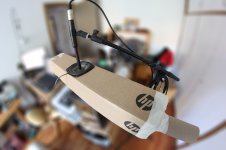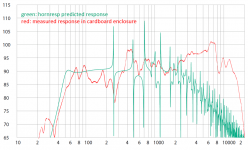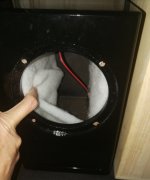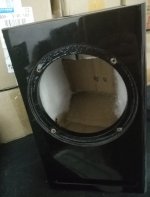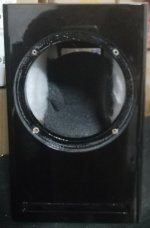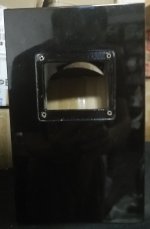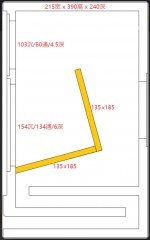Love this thread - it is about playing and learning just for fun. Makes me want to make some cardboard open-baffles...
I had a feeling that word would appear in this thread, but not with this speaker. This is the front view. The finish can be improved by using a card sheet to smooth out the sides and hide the corrugation.that's one f'ugly speaker i like it...
I compared the sound with headphones and it compared well in clarity, but not in bass. Headphones anyway are lacking in punch. To recap- car door speakers are said to have a pronounced mid range since they are competing with road noise, and maybe engine sounds.
Source material has a huge effect: some of my mp3s were very low volume I had to normalize them.
Well thanks. Learning a lot. Lots of pillars of success here (failures are the pillars of success)Love this thread - it is about playing and learning just for fun
Cardboard or no, I am having a problem with room placement: these speakers sound better 1 metre away from the wall. That means stands. That means taking a stand if you know what I mean. That means cardboard stands... maybe.
The Diamond 4s with their rear ports do not seem to be so sensitive to placement, actually nearer the wall seems better.
Any ideas?
I would say that the rear ports interact with the wall giving a room-interaction bass boost.The Diamond 4s with their rear ports do not seem to be so sensitive to placement, actually nearer the wall seems better.
What if you made the baffle much larger?
Plans for a passive radiator in a sealed box, repurposing the XBS passive radiator (blue). Speaker driver graphic is not accurate.

Contrary to popular belief, looks are important, I don't want it to look too big for the room. Having a partially blocked port (cant remember what it is called) may be one answer.What if you made the baffle much larger?
That's the nature of dipoles. Normally they're even farther out into the room than 1 meter. You can get them closer to side walls without as much impact on the sound, but close to the rear wall is typically not done.these speakers sound better 1 metre away from the wall.
What about drivers? It is possible that these units are not really full range. Anyone used the 3 inch full range speakers?
They seem to be good enough without any tone adjustments and they just might work with a the bass tone controls turned up.
They seem to be good enough without any tone adjustments and they just might work with a the bass tone controls turned up.
^i second that.
cardboard is good as long as you do not have any low frequency resonance in the box/enclosure.
so it may be ok as open baffle or midrange enclosure.
closed box, bass reflex or passive radiators all deal with a low frequency resonance for bass reproduction (thus air pressure).
this requires airtight installation of driver and stiff enclosure.
as a result to low stiffness the cardboard box itself will act as an uncontrolled passive radiator.
I once tested a cardboard mass loaded quarter wave resonator, see images. it worked better than i expected but as you can see from the measured response it still is not ideal (by the way the measurement shown was "midfield" with about 50 cm distance from driver and port - not driver nearfield as shown in the photo!)
the box i used was reasonably stiff, because of it's geometry. the main problem was mounting the driver airtightly in the soft cardboard.
cardboard is good as long as you do not have any low frequency resonance in the box/enclosure.
so it may be ok as open baffle or midrange enclosure.
closed box, bass reflex or passive radiators all deal with a low frequency resonance for bass reproduction (thus air pressure).
this requires airtight installation of driver and stiff enclosure.
as a result to low stiffness the cardboard box itself will act as an uncontrolled passive radiator.
I once tested a cardboard mass loaded quarter wave resonator, see images. it worked better than i expected but as you can see from the measured response it still is not ideal (by the way the measurement shown was "midfield" with about 50 cm distance from driver and port - not driver nearfield as shown in the photo!)
the box i used was reasonably stiff, because of it's geometry. the main problem was mounting the driver airtightly in the soft cardboard.
Attachments
Last edited:
Yes, I've used them and tried many different models.What about drivers? It is possible that these units are not really full range. Anyone used the 3 inch full range speakers?
"Full range" is open to interpretation, especially on smaller drivers. It's generally used to mean a much wider bandwidth than a typical midrange or tweeter would produce on their own. It doesn't mean 20 Hz to 20 kHz.
There are no 3-inch full range drivers that are going to make significant bass. There's just not enough volume displacement to do it. Some of them can give a pleasing sound, but significant amounts of bass from a driver that small are typically not feasible. Sitting very close to the speakers can help, but physics are physics.
When small drivers do make decent bass, it's usually at the cost of sensitivity and loss of higher frequencies, since mass has to increase significantly to get the driver's free air resonance low enough to allow it to play down there and to allow for enough excursion to make some semblance of bass. The Tang Band W3-1876S is one example of what that trade-off looks like
https://www.parts-express.com/Tang-Band-W3-1876S-3-Mini-Subwoofer-264-909?quantity=1
Last edited:
The first set of speaker I built was out of plywood, that was in 1991. They sounded OK but I never managed to seal them, and in any case were running off boomboxes and low end (YORX) stereo systems. When I took speaker building again in 2015, I tried many different designs, including open baffle. I got a complete cabinet build but never finished it off because I could not make it look good enough to fit in with the furniture. Eventually I gave them away.i know i'm not going to convince you but if you want better bass change enclosure material...
Moving to the Maldives, I brought very little with me, and the best I can hope for is to get some 4 mm plywood pieces locally or online and hacksaw and glue them together.
The important thing now is to come up with a design that works, I can always go to plywood later. In the past week I have built 4 different speaker designs and tested them, impossible with plywood without a workshop.
What is the difference in low bass output for a cardboard speaker vs a plywood or MDF? 50%. 25%? I have the Diamond IVs sitting here near my desk but with a nice woofer and obviously a crossover inside, not to mention the port.
The chart shows dB level vs frequency? What is the lowest frequency - 40Hz? What do you mean by not ideal is it the uneven response - which can be EQd out or not?I once tested a cardboard mass loaded quarter wave resonator, see images.
passive radiators are ideal for small enclosures. but you need to make sure the enclosure is airtight and stiff.
and you should calculate the correct box volume, matching passive radiator and eventual added weigth for it.
the green curve shows the energy FR, this is why the measured red curve is much higher at high frequency (beaming of speaker).
but the absolute values do not say much, as you will have another driver and another enclosure.
the graph shows plenty of resonances of the soft cardbord faces.
and you should calculate the correct box volume, matching passive radiator and eventual added weigth for it.
yes. frequency from 10 Hz to 20 kHz.The chart shows dB level vs frequency?
the green curve shows the energy FR, this is why the measured red curve is much higher at high frequency (beaming of speaker).
but the absolute values do not say much, as you will have another driver and another enclosure.
the graph shows plenty of resonances of the soft cardbord faces.
I mentioned in post #19 using cardboard for TL(onken) internal dividers and braces. Well I just swapped out the driver of one, a 5L 4.5", and placed my new 4" FE108eSigma over the hole. Earlier I had done the same with its unmodified slot-loaded BR mate and there was basically no bass. But the "cardboard inside" TLonken worked -- acceptable bass (especially for a new driver) playing organ and piano deep fortissimo. Tone sweep decent too judging by ear. Hmm. @planet10 @GM
I prototyped my TLonken folded transmission lines with hard cardboard dividers, often brute-forced into place and self-braced. Much easier than using plywood. One worked so well I did its mate in ply and found only a trace of coloration (warmth) from the cardboard TL, less than that imparted by a typical MDF cab.
Any pictures of this? So the dividers were cardboard, but the enclosure was plywood or MDF? Also, drivers are important, what was the stated Fs of the two drivers and did this predict their characteristics? Fs is listed as 77 Hz. The Fostex is a solid looking speaker.
Here is a link to the famous Negaoka Tetsuo Swan folded horn design for the FE108E∑ speaker. This horn produces bass response that is astonishing for such a small speaker. http://spida.art.coocan.jp/eng-page7.htm
https://www.madisoundspeakerstore.com/approx-4-fullrange/fostex-fe108ez-4-full-range-sigma-series/
Last edited:
In a fit of demensia (I needed to make a de novo comparison BR vs TL) I ripped out that (nearly) perfectly good cardboard line (sob). The 10L 1.3m fingered-oak TLonken had been made/modded for 5.5" Eve Audio fiberglass honeycomb drivers (aerospace technology) Fs~53hz IIRC. Now they house Hifi-Bird aka Isred/MichaelAudio/MKHIFI "English drum paper" my favorite whizzerless fullrange driver. Both drivers have low-ish Qts.
But the 5L "cardboard inside" TLonken is intact and I will later take a picture of it. Worked well enough with the "hard to get bass out of" FE108eSigma (planet10). Its Qts is middling and Fs is pretty high.
Described in this thread https://www.diyaudio.com/community/threads/desktop-transmission-line.391306/post-7150183
(pictured in post #23 below it)
But the 5L "cardboard inside" TLonken is intact and I will later take a picture of it. Worked well enough with the "hard to get bass out of" FE108eSigma (planet10). Its Qts is middling and Fs is pretty high.
Described in this thread https://www.diyaudio.com/community/threads/desktop-transmission-line.391306/post-7150183
(pictured in post #23 below it)
Last edited:
Some pics of the 5L piano-black single-slot-loaded Onken, typical of design but very well made & sold by Michael Audio with 5" (actual 4.5) drum-paper fullrange driver. I got one pair new and one pair used on Idlefish Market (both for less than half price) after hearing audio-clips. First pic is unmodded cab. Last pic is the (same) design schematic for a bigger ready-made labyrinth cab.
Low Qts and low Vas are probably best suited for the TLonken short tapered line. Best cardboard to use is probably the shiny-faced hard/thick kind, folded into square tubes and taped/self-braced.
A more serious mini TLonken construction using ply and mdf:
https://www.diyaudio.com/community/...rkaudio-alpair-5-2-in-evansound-3-75l.393909/
Bigger one:
https://www.diyaudio.com/community/threads/supravox-8-tlonken-while-city-of-22m-laid-flat.393338/
Low Qts and low Vas are probably best suited for the TLonken short tapered line. Best cardboard to use is probably the shiny-faced hard/thick kind, folded into square tubes and taped/self-braced.
A more serious mini TLonken construction using ply and mdf:
https://www.diyaudio.com/community/...rkaudio-alpair-5-2-in-evansound-3-75l.393909/
Bigger one:
https://www.diyaudio.com/community/threads/supravox-8-tlonken-while-city-of-22m-laid-flat.393338/
Attachments
- Home
- Loudspeakers
- Planars & Exotics
- Are cardboard enclosures any good?
